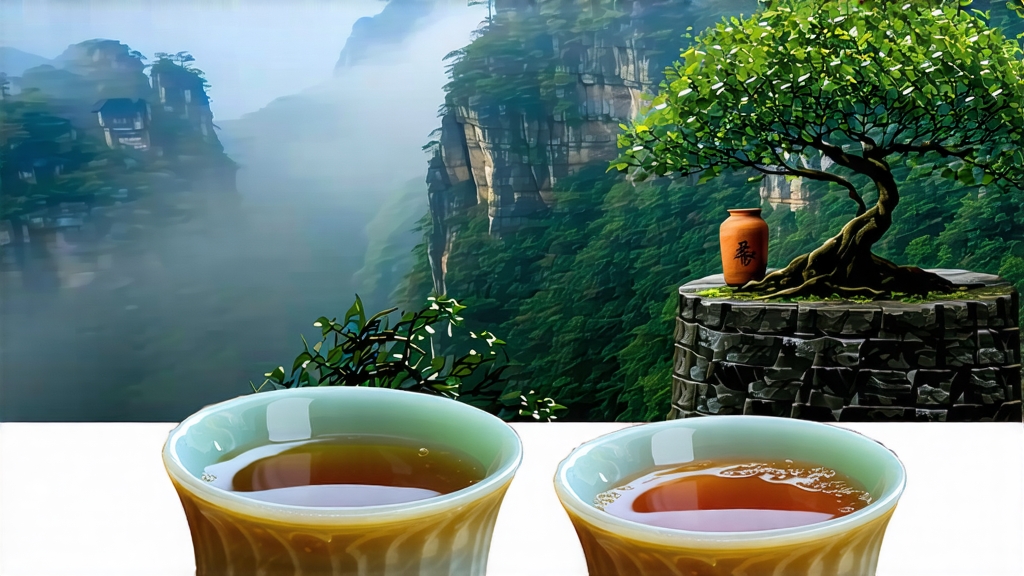
High in the Wuyi Mountains of northern Fujian, where the Jiuqu Xi River coils like a silk ribbon through granite cliffs, grows an oolong cultivar whose name translates simply as “Water Sprite.” Locals insist the title is modest: Shui Xian, they say, is less a fairy than a mountain spirit distilled into leaf form. For six centuries its long, midnight-green blades have been rolled, roasted, and coaxed into a liquor that tastes of wet stone, orchid, and burnt caramel—an echo of the very cliff gardens that nursed it.
-
From Song Dynasty Cuttings to Global Cups
The first written record appears in 1392, when a monk at the Wuyi Tianxin Temple transplanted wild tea bushes onto a narrow ledge known as “Ghost Cave.” The cuttings thrived in the mineral-rich fissures, developing leaves twice the normal thickness. By the early Qing, the cultivar had migrated down the mountain to the village of Huiyuan, where the Chen and Lin families perfected the triple-charcoal technique that still defines authentic Shui Xian. When British tea thief Robert Fortune passed through in 1848 he dismissed the dark, heavily oxidized leaves as “too rugged for civilized palates,” yet by the 1920s Shui Xian was the highest-priced tea at the Canton Trade Fair, fetching thirty times the value of Keemun. Today, 70 % of the 3,800 tons exported annually are sold to North American specialty cafés that market it under the romantic label “Narcissus Oolong,” a mistranslation that nevertheless captures the tea’s lingering floral note. -
Terroir: The “Rock Rhyme” Paradox
UNESCO lists the 60 km² Wuyi core zone as a World Heritage site for its Danxia landforms—purple-red conglomerate cliffs that absorb daytime heat and release it slowly through the night. Shui Xian roots must bore 30 cm into these stones to reach trapped rainwater, absorbing calcium, magnesium, and micro-nickel ions that create the coveted yan yun, literally “rock rhyme.” Tasters describe yan yun as a tingling mineral echo that arrives 30 seconds after swallowing, climbing from the sides of the tongue to the molars. Only gardens above 400 m within the official “Zheng Yan” polygon—comprising Niulan Keng, Huiyuan Keng, and the three-mile “Ghost Cave” corridor—can legally sell their leaf as “cliff core.” One mu (0.067 hectare) of such land rents for the price of a Beijing apartment, and pickers ascend at 4 a.m. to finish before the sun warms the rocks and dilutes the ionic concentration. -
Cultivar Botany: The Big-Leaf Outlier
Unlike the petite Tie Guan Yin bush, Camellia sinensis var. shuixian grows into a small tree reaching three meters. Its mature leaves—10 cm long, 4 cm wide—contain 3.2 % linalool (the orchid compound) and an unusual 2.8 % geraniol, double that of most oolongs. Because the trunk lignifies quickly, farmers prune only every third year, allowing older branches to develop a sponge-like bark that stores dew. The cultivar is also polyploid (2n = 45), a chromosomal quirk that thickens cell walls and delays oxidation, giving the master processor a wider window to shape flavor. -
Craft: The Eight-Stage Cliff Ballet
a. Pluck: two leaves and a bud, 45 % maturity, when the leaf tip angles 30° downward.
b. Solar Wither: 25 minutes on 45 °C rock ledges; the reflected heat jump-starts enzymatic activity.
c. Indoor Wither: 4 hours on bamboo racks in a 23 °C cave; 70 % water loss, leaf edges turn coral.
d. Shaking: 5 rotations per minute for 12 minutes, repeated 3 times; bruising releases geraniol.
e. Oxidation: 65 %, the highest among Wuyi oolongs; leaves piled 8 cm deep in cedar trays for 2.5 hours.
f. Kill-Green: 260 °C wok, 4 minutes; the sudden heat fixes the burgundy rim while preserving green center.
g. Rolling